The AMD Radeon R9 Fury Review, Feat. Sapphire & ASUS
by Ryan Smith on July 10, 2015 9:00 AM ESTCompute
Shifting gears, we have our look at compute performance. As compute performance will be more significantly impacted by the reduction in CUs than most other tests, we’re expecting the performance hit for the R9 Fury relative to the R9 Fury X to be more significant here than under our gaming tests.
Starting us off for our look at compute is LuxMark3.0, the latest version of the official benchmark of LuxRender 2.0. LuxRender’s GPU-accelerated rendering mode is an OpenCL based ray tracer that forms a part of the larger LuxRender suite. Ray tracing has become a stronghold for GPUs in recent years as ray tracing maps well to GPU pipelines, allowing artists to render scenes much more quickly than with CPUs alone.

For LuxMark with the R9 Fury X already holding the top spot, the R9 Fury cards easily take the next two spots. One interesting artifact of this is that the R9 Fury’s advantage over the GTX 980 is actually greater than the R9 Fury X’s over the GTX 980 Ti’s, both on an absolute and relative basis. This despite the fact that the R9 Fury is some 13% slower than its fully enabled sibling.
For our second set of compute benchmarks we have CompuBench 1.5, the successor to CLBenchmark. CompuBench offers a wide array of different practical compute workloads, and we’ve decided to focus on face detection, optical flow modeling, and particle simulations.
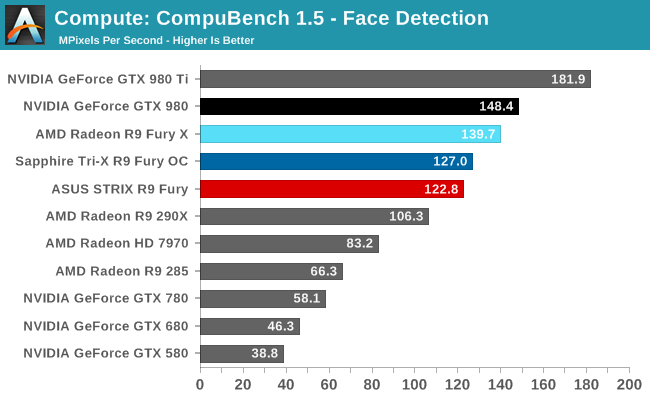
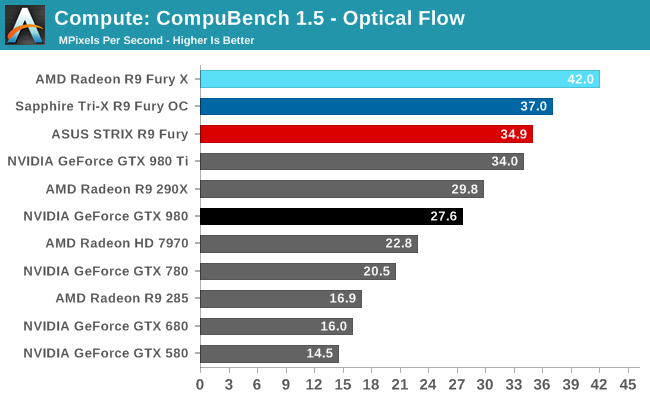

Not unlike LuxMark, tests where the R9 Fury X did well have the R9 Fury doing well too, particularly the optical flow sub-benchmark. The drop-off in that benchmark and face detection is about what we’d expect for losing 1/8th of Fiji’s CUs. On the other hand the particle simulation benchmark is hardly fazed beyond the clockspeed drop, indicating that the bottleneck lies elsewhere.
Our 3rd compute benchmark is Sony Vegas Pro 13, an OpenGL and OpenCL video editing and authoring package. Vegas can use GPUs in a few different ways, the primary uses being to accelerate the video effects and compositing process itself, and in the video encoding step. With video encoding being increasingly offloaded to dedicated DSPs these days we’re focusing on the editing and compositing process, rendering to a low CPU overhead format (XDCAM EX). This specific test comes from Sony, and measures how long it takes to render a video.
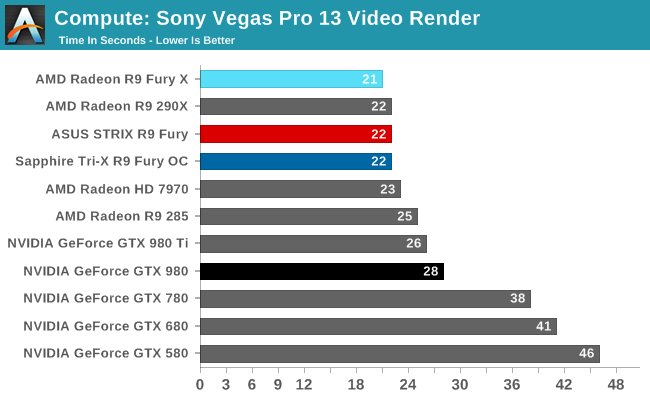
At this point Vegas is becoming increasingly CPU-bound and will be due for replacement. The R9 Fury comes in one second behind the chart-topping R9 Fury X, at 22 seconds.
Moving on, our 4th compute benchmark is FAHBench, the official Folding @ Home benchmark. Folding @ Home is the popular Stanford-backed research and distributed computing initiative that has work distributed to millions of volunteer computers over the internet, each of which is responsible for a tiny slice of a protein folding simulation. FAHBench can test both single precision and double precision floating point performance, with single precision being the most useful metric for most consumer cards due to their low double precision performance. Each precision has two modes, explicit and implicit, the difference being whether water atoms are included in the simulation, which adds quite a bit of work and overhead. This is another OpenCL test, utilizing the OpenCL path for FAHCore 17.
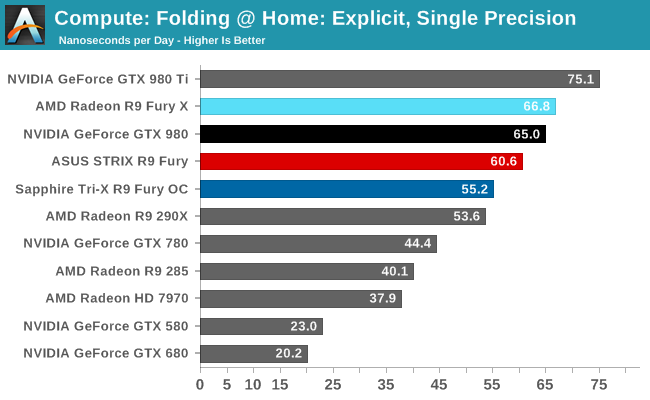
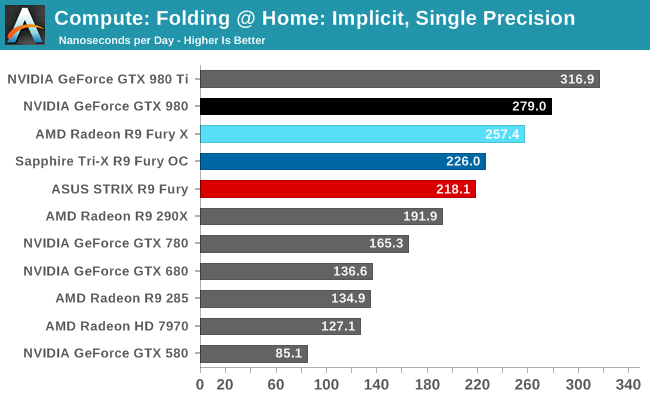

Overall while the R9 Fury doesn’t have to aim quite as high given its weaker GTX 980 competition, FAHBench still stresses the Radeon cards. Under single precision tests the GTX 980 pulls ahead, only surpassed under double precision thanks to NVIDIA’s weaker FP64 performance.
Wrapping things up, our final compute benchmark is an in-house project developed by our very own Dr. Ian Cutress. SystemCompute is our first C++ AMP benchmark, utilizing Microsoft’s simple C++ extensions to allow the easy use of GPU computing in C++ programs. SystemCompute in turn is a collection of benchmarks for several different fundamental compute algorithms, with the final score represented in points. DirectCompute is the compute backend for C++ AMP on Windows, so this forms our other DirectCompute test.
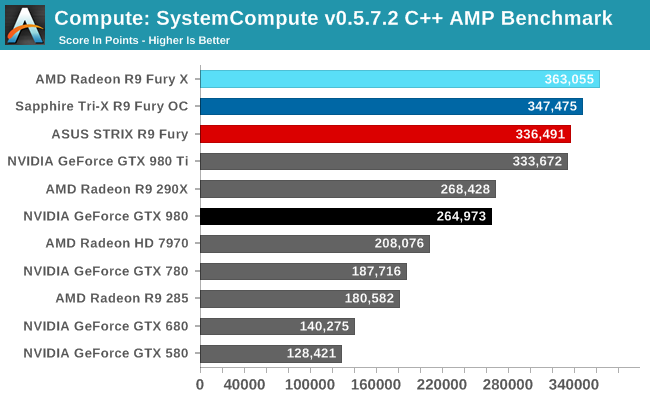
As with our other tests the R9 Fury loses some performance on our C++ AMP benchmark relative to the R9 Fury X, but only around 8%. As a result it’s competitive with the GTX 980 Ti here, blowing well past the GTX 980.










288 Comments
View All Comments
refin3d - Friday, July 10, 2015 - link
I think they really have. Ryan mentioned it in the review, I think on the test setup page and the one after. I just installed the 15.7 drivers for my 290x and haven't had a chance to properly test but this looks very promising.FlushedBubblyJock - Wednesday, July 15, 2015 - link
I see, over 2 years after release, there's " a very promising amd driver performance upgrade !"I guess undie stripes went out with poopless bowel movements too, check the reviews.
rocky12345 - Friday, October 16, 2015 - link
why are you being such a dick bubbly? even when everyone can clearly see that the last couple of driver releases for amd have perked up the 290/290x as well as the 390/390x cards you throw out cheap shots at anyone that mentions that or anything else about amd.Yes there is some fanboyism coming from both sides that is to be expected but you sir are just here to be a jerk to anyone that happens to like AMD, I'm not a fanboy for either side Ihave Nvidia and AMD cards in my gaming rigs which are AMD Sapphire R9 390X tri-X 8GB & a Nvidia Geforce GTX 980 4GB in the other system and both on Intel i7's both cards work very close to each other but I find the 390x seems to be smoother in a lot of games at 1440p max sttings than the 980gtx not sure why maybe the extra memory.
Anyways just chill people will be people they get excited says stupid sh*t in the heat of the moment. This is not a personal attack on anyone just tired of the bickering. both companies rock when it comes to graphics cards.
mdriftmeyer - Friday, July 10, 2015 - link
Not impressed benching Gameworks optimized titles.Oxford Guy - Saturday, July 11, 2015 - link
Is that hair nonsense turned on?FlushedBubblyJock - Wednesday, July 15, 2015 - link
I agree awesome realism in games sucks. I like blurry and like low level cartoonish only.Why have things look true to life ?
This is amd gaming.
Shadowmaster625 - Friday, July 10, 2015 - link
60 less watts when your system is pulling over 300 watts doesnt really mean anything. What matters is how quiet that sapphire card runs. That's exactly what I would buy, hands down.FlushedBubblyJock - Wednesday, July 15, 2015 - link
YEP I TOTALLY AGREE - that's why I ALWAYS spend THAT EXTRA $60 BUCKS OVER $300 ON THE NVIDIA CARD !CAUSE who cares about 60 when yer over 300 ....
EXCELLENT ! Thank you amd fanboy !
mikato - Wednesday, July 15, 2015 - link
Give it a rest will you?mr_tawan - Friday, July 10, 2015 - link
If we put on the water cooler on the Fury, is it possible the the card will perform as well as the Fury X? I wonder.